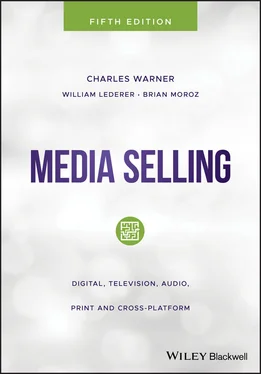Customization means that every sales call, every proposal, and every presentation has to be crafted differently and, of course, it takes time to do in‐depth research to understand a client’s industry, goals, strategies, creative approach, and personal needs. Also, one critical part of the customization process is analyzing a multitude of data available on a client to find insights that might help a client get better results through its advertising efforts.
New approach 1: Serving the customer
Chapter 9in Daniel Pink’s 2012 book titled To Sell Is Human: The Surprising Truth About Moving Others is titled “Serve.” Pink writes: “[Servant selling]…begins with the idea that those who move others aren’t manipulators but servants. They serve first and sell later.” 13
Facebook does not have a sales division; it has a partnership group. The difference is that a pre‐Internet‐era media sales department handled transactions, but the Facebook partnership group works with advertisers and marketers to educate them on the best way to use Facebook’s ability to micro‐target consumers on a wide range of behavioral, psychographic, gender, and preference dimensions.
A serving‐the‐customer, partnership approach means that both the buyer and the seller are interested in enhancing the growth and profitability of each. They are on the same side and have the same mission, goals, and strategies for growth and, most importantly, are not adversaries who are trying to maximize just their own profits.
The concept of selling as serving, or helping, customers is vital in the digital era. Media salespeople must take the approach that they are helping marketers be successful. Media salespeople help advertising agency buyers get what they want for their clients and help advertisers get results as advertisers define results.
The importance of the perspective of selling as helping others is reinforced dramatically in Johann Hari’s 2018 book, Lost Connections , in which the author recaps several scientific studies that show that often people are happier when they do something for someone else than when they do something for themselves. This unexpected conclusion comes from studies by evolutionary biologists that suggest homo sapiens became the dominant species on earth primarily because we learned to cooperate, to help others, to be primarily concerned about the welfare of the tribe, or the community, rather than to be selfish and primarily concerned about our own, individual welfare. We learned to share, to cooperate, in order to survive. 14
Thus, many people (not all) are happiest and feel more fulfilled when they are helping and serving others. They get more intrinsic value from connecting with people and helping them. Also, when you sell local media advertising, you are helping to fuel the economy and enabling your community to remain prosperous by helping local businesses be successful. 15
Following are some definitions that will clarify the concepts of selling as serving and clients as partners:
Buyers are divided into three types: prospects, customers, and partners.Prospects are people who have not bought a product for a variety of reasons, ranging from never having heard of it to disliking it; prospects require missionary selling. In the media, prospects might be those people who: (1) have never before advertised because they have an established business that they feel does not need advertising; (2) have never advertised before because they are starting a new business; (3) advertise but not in your medium; or (4) advertise in your medium but do not use your platform, website, mobile app, network, station, newspaper, cable system, or magazine.Customers are people who have either decided to buy a product or who have already bought a product and are going to buy it again. Customers require outrageous service that will delight them and make them “raving fans.” 16 Partners are customers who have collaborated with a media company to conduct business based on mutual trust and, in a sense, to help each other to be more successful by cooperating in discovering innovative solutions that connect a partner to a medium’s audience in a way that delivers partner‐defined results and jointly builds the business of both companies.
Investments are advertising dollars placed in the media. In the past advertising money has been “spent” in the media; however, many marketers and their advertising and media agencies have realized that advertising is an investment in future sales of a product. Major media agencies promote the concept of advertising as an investment. For example, WPP’s media agency Group M refers to itself as “the world’s largest investment group.” 17 Media salespeople should always refer to advertising as an investment. Thus, rather than asking a prospect, “How much money do you spend in advertising?” ask, “How much money do you invest in advertising?” It is important for media salespeople to educate marketers about the fact that their advertising is an investment.
Products are either tangible or intangible. Tangible products are goods that can be seen and touched, such as automobiles, personal computers, or cosmetics. Intangible products are services that cannot be seen, touched, or tested in advance, such as insurance, financial services, or advertising. Tangible products can be experienced and they are usually easy to demonstrate – product features and benefits are apparent before a purchase. However, even tangible products have some degree of intangibility, as pointed out by Theodore Levitt, “You can't taste in advance or even see sardines in a can or soap in a box. This is common for frequently purchased moderate‐ to low‐priced consumer goods. To make buyers more comfortable and confident about tangibles that can’t be pre‐tested, companies go beyond the literal promises of specifications, advertisements, and labels to provide reassurance.” 18
Packaging is one common tool used to make the intangible elements of products more tangible in a consumer's mind – for example, putting pickles in a glass jar so purchasers can see them. Advertising is another tool used to communicate advance assurances that a product is what it says it is.
It is harder to keep customers satisfied with intangible products than with tangible ones. The biggest problem with intangible services – such as advertising, insurance, or banking services – is that customers are usually not aware of the full range of services they are getting until they no longer get them. Therefore, they rarely appreciate the positives, and the negatives tend to be blown out of proportion. This situation means that intangibles require more service and greater efforts on the part of salespeople. From now on all products and services will be referred to as products, whether they are tangible or intangible.
New approach 2: Focus on customer success
In 2003 Mel Karmazin’s CBS television and radio salespeople’s approach had not changed since I was Eastern Sales Manager and then VP and General Manager of CBS Radio Spot Sales from 1967 to 1971. The approach was internally focused, and its sole purpose was to maximize revenue for CBS and the stations Radio Spot Sales represented. This maximizing revenue approach meant that salespeople sold the “magic,” which was typically audience estimate numbers (ratings) and promises of ad positioning that they often could not keep. For example, a media buyer would place an order with a local television station salesperson for a schedule of 12 spots a week that were to run for a month in morning, early, and late news programs. However, one‐third of the scheduled 48 spots would be preempted (not run) for various phantom reasons such as “technical difficulties.” Station sales managers would preempt a part of virtually all schedules to take subsequent orders placed at higher rates. Therefore, an inordinate amount of salespeople’s time was spent negotiating makegoods with media buyers, who were made furious over this preemption‐and‐makegood process. This system was highly inefficient, ethically questionable, and totally self‐serving, not customer serving or customer focused. Such a system was based on the leverage that local television and high‐rated radio stations and television networks took advantage of because they had scarce ad inventory that was in high demand.
Читать дальше












